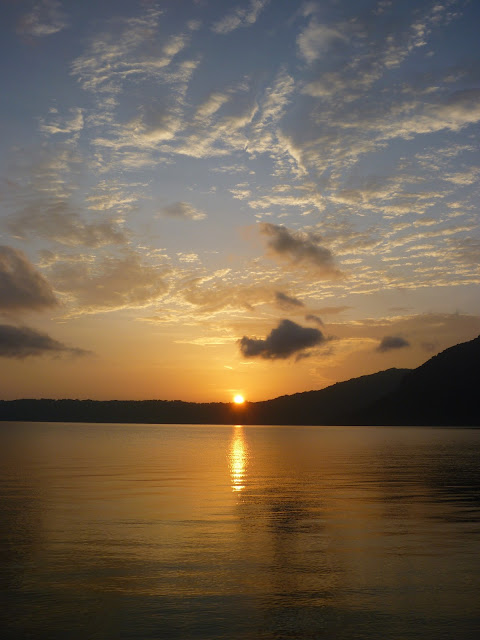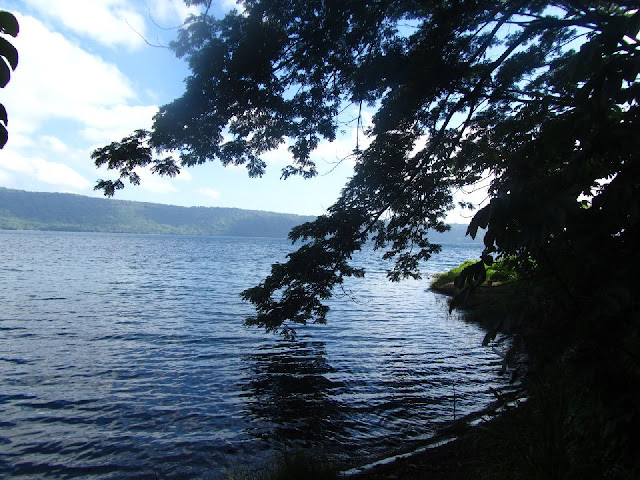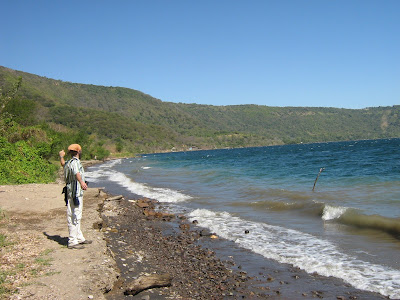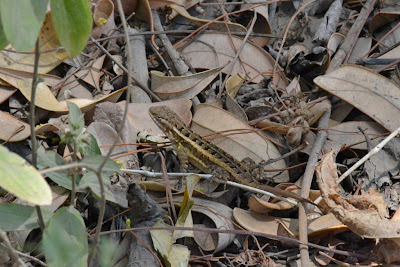The dry season in Nicaragua, which encompasses the first several months of the year, was especially hot and dry this year. Forest fires raged through parched lands throughout the country, especially in protected areas, such as
Volcano Masaya National Park.
Almost all forest fires in the tropics are started by humans, and we are sure that the fires which burned hundreds of hectares of brush and forest on the sides of the Masaya Volcano were no exception. In fact, someone was caught setting fires, although catching someone does not return the great losses caused in nature. It was a severe dry season, so the elements were especially susceptible to a forest fire.
This weekend,
FUNDECI/GAIA participated in a tree-planting activity in Volcano Masaya National Park, and here are some photos which depict the activity. Volunteers came from all directions, and together, we planted about one hundred stakes which will, hopefully, become trees. Special thanks to
Apoyo Spanish School student Elizabeth Loudon for doing her part!
 |
| The Masaya Volcano is smoking behind the reforestation volunteers. Photo Jeffrey McCrary. |
The
reforestation activity was done with stakes from trees with branches that can be planted directly. Not all trees do this, of course, but some of these species are found in the
Volcano Masaya National Park. We cut branches from some large trees, and planted them in holes 1/2-meter depth in the areas where forest fires raged during April.
 |
| Trees were planted from cut stakes. Photo Jeffrey McCrary. |
Our reforestation project was done by volunteers from all directions-
Nicaragua, Europe, and the United States. Every volunteer was enthusiastic about helping their natural heritage prosper. Work as a volunteer in Nicaragua is not always meaningful, but we came back knowing we participated in a great activity.
 |
| Burned areas are all around! Ilse plants a Sacuanjoche tree. Photo Jeffrey McCrary. |
 |
| More stakes arrive foor planting. Photo Jeffrey McCrary. |
 |
| Environmental volunteers arrive. Photo Jeffrey McCrary. |
 |
| The Volcano Masaya crater gapes behind Elizabeth. Photo Jeffrey McCrary. |
 |
| Natasha digs like a pro. Reforestation volunteers came from Carazo, Managua, Nindiri, Masaya, and Laguna de Apoyo. Photo Jeffrey McCrary. |
 |
| The reforestation volunteers were enthusiastic! Photo Jeffrey McCrary. |
The reforestation activity, performed by environmental volunteers and the staff of the Volcano Masaya National Park, was covered by the national newspaper,
La Prensa. Every volunteer was happy to participate. The event was actually fun!
 |
| The ground was covered in black ash from the forest fire, and charcoal from the branches and stems that were burned.. We found rich soil in a shallow layer, followed by volcanic gravel beneath, as we dug holes for planting stakes. Photo Jeffrey McCrary. |
 |
| Volunteers for the reforestation project came from Masaya, Nindiri, Managua, and Laguna de Apoyo. Photo Jeffrey McCrary. |
Reforestation in Nicaragua is greatly needed in many areas. So many forests have been degraded or destroyed by fires, expansion of agriculture and clearing for wood use. We are happy to have participated, especially because we saw the enthusiasm of the Nicaraguan volunteers. No one provided meals or expense accounts, everyone just came and gave their time and energy, and returned home sweaty and covered in dirt and ash, knowing that Volcano Masaya is better protected than before.
 |
| The ash from the fire is evident around the hole dug by these volunteers. Photo by Jeffrey McCrary. |
If you would like to participate in meaningful projects which have a place in the greater benefit of Nicaraguans, then consider being a
volunteer with
FUNDECI/GAIA. You can help
save the planet, one tree at a time. It is easy to be an environmental volunteer in Nicaragua. There are many
environmental projects and activities, and there is always something to do for every volunteer.
 |
| Our contribution was small, but these reforestation volunteers are happy to have participated! Photo Lenin Medina. |













































